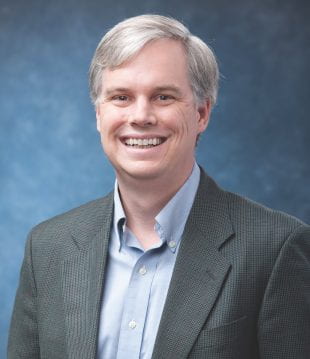Mike Williams
713-348-6728
mikewilliams@rice.edu
NIH supports mathematical optimization of tumor treatment
Research aims to reduce side effects of radiation therapy for head and neck cancer
HOUSTON – (June 2, 2021) – A new strategy to reduce the side effects suffered by patients undergoing treatment for head and neck cancers now has the support of the National Institutes of Health.
Andrew Schaefer, the Noah Harding Chair and a professor of computational and applied mathematics and computer science at Rice’s Brown School of Engineering, won a prestigious four-year R01 grant for $1.2 million to develop a personalized approach to adaptive radiation therapy (ART) for head and neck cancers.
The goal of the study is a tool to personalize chemo- and radiation-based therapies that both reduce risks to patients and make the process more efficient for providers.
Schaefer is working with co-investigators Clifton Fuller, an associate professor in the Department of Radiation Oncology at the University of Texas MD Anderson Cancer Center, and Rice colleagues Mallesh Pai, an associate professor of economics, and Joey Huchette, an assistant professor of computational and applied mathematics.
Head and neck cancers account for nearly 3% of cancers in the United States and most commonly affect people over 50, mostly men. Of primary concern is unwanted damage from radiation to structures adjacent to tumors, including glands, bone and muscle related to speech, eating and swallowing.
The grant, which is administered by the National Cancer Institute, will allow Schaefer and his team to develop a mathematical model that helps providers optimize both individual treatment strategies for patients and health care providers’ policies for the implementation of new technology.
ART will take advantage of computerized tomography (CT) technology in use since the early 2000s. It allows clinicians who gather real-time images of changes in a tumor to adapt treatment. ART-based strategies vary. The simplest “fixed-interval” approach requires a midstream reconsideration of therapy, and the most sophisticated “cascade” approach involves daily evaluation of tumors and continual adjustment of chemotherapy and/or radiation in response to changes in tumor geometry.
Schaefer and colleagues plan to feed imaging data into custom Markov decision processes, mathematical models commonly used to optimize decisions over time in dynamic situations. Schaefer compared the models to maps that suggest how a driver should change course when an unexpected roadblock appears.
“The models are going to allow us to adaptively decide how we’re going to adjust a treatment,” he said. “It will be real-time navigation, not through a physical space but through all the treatment options.”
ART, he said, replaces one-time, up-front decisions about a patient’s treatment with a set of points requiring a decision to replan, thus balancing the needs of all parties.
“Replanning treatment for a patient on the fly, no matter which model is employed, realistically concerns parties with different incentives: the insurer, including Medicare, and the clinical team, including the patient,” Schaefer said.
Schaefer, who earned bachelor’s and master’s degrees in computational and applied mathematics at Rice in 1994, said MD Anderson has one of the first MRI-guided linear accelerators (MR-linAc), which will enable cascade treatment plans by allowing for real-time views of tumors during therapy.
He said the team will develop the best cascade treatment plans for a variety of patients under conditions of uncertainty, and come up with the best simple policies for implementing those policies at cancer centers without MR-linAc machines. The researchers will also work to understand the insurance implications in all treatment plans.
“Just like with other drug regimes, some bodies are going to tolerate radiation very well and some not at all,” Schaefer said. “With head and neck cancers, there are a lot of organs we’re trying to protect because we can’t deliver radiation to precisely the tumor and nothing else around it.
“So there are trade-offs,” he said. “This program will let us adapt our plan of treatment to what we see in terms of toxicity to the patient and what happens to the tumor. This new generation of machines is going to allow us to re-plan treatment in a much more agile fashion.”
For facilities without the latest imaging technology, “We’re going to be able to say, these are the adjustments we make for patients in a similar situation,” Schaefer said.
-30-
Read the abstract at https://reporter.nih.gov/search/ZNqyYliAjk2LTcH_LhjAAQ/project-details/10167245#details.
This news release can be found online at news.rice.edu.
Follow Rice News and Media Relations via Twitter @RiceUNews.
Related materials:
Andrew Schaefer: https://www.caam.rice.edu/~andrew.schaefer/
Department of Computational and Applied Mathematics: https://www.caam.rice.edu
George R. Brown School of Engineering: https://engineering.rice.edu
Images for download:
https://news2.rice.edu/files/2021/05/0524_SCHAEFER-1a-WEB.jpg
CAPTION: Andrew Schaefer (Credit: Rice University)
Located on a 300-acre forested campus in Houston, Rice University is consistently ranked among the nation’s top 20 universities by U.S. News & World Report. Rice has highly respected schools of Architecture, Business, Continuing Studies, Engineering, Humanities, Music, Natural Sciences and Social Sciences and is home to the Baker Institute for Public Policy. With 3,978 undergraduates and 3,192 graduate students, Rice’s undergraduate student-to-faculty ratio is just under 6-to-1. Its residential college system builds close-knit communities and lifelong friendships, just one reason why Rice is ranked No. 1 for lots of race/class interaction and No. 1 for quality of life by the Princeton Review. Rice is also rated as a best value among private universities by Kiplinger’s Personal Finance.


